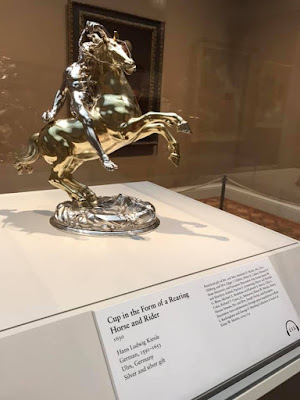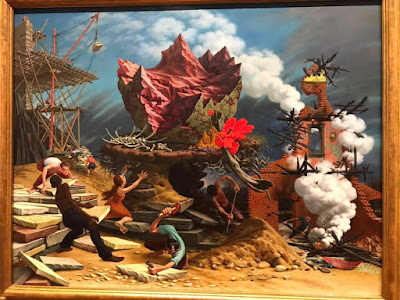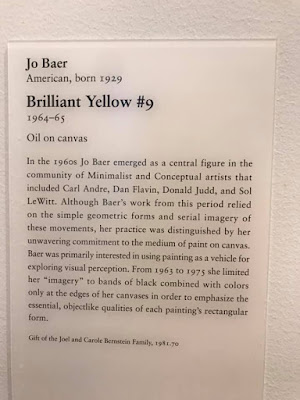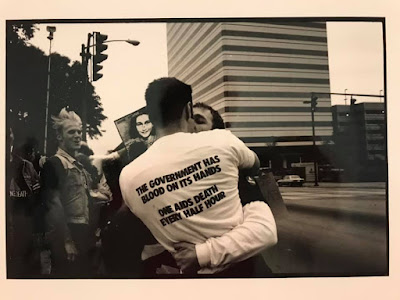9 May 2019
Squeezed in a tight 2-hour visit to Chicago History Museum in the morning.
Started off with the Chicago: Crossroads of America exhibition.
The Haymarket Affair of 1886 - the birth of May Day.
Then the race riots.
The Eastland Disaster.
Next gallery: KPMG and Paul & Katherine Snyder Gallery on Dr Martin Luther King Jr.
The Chicago Fire led to many architects descending on Chicago to rebuild the City.
Now, to fashion at the Silver Screen to Mainstream: American Fashion in the 1930s and 40s exhibition.
Moving on to Sensing Chicago exhibition.
And quite a good coverage on labour unions:
We met Nicole Haley, General Counsel, Teamsters Local 700, a union that represents public sector employees in Illinois. We had a long discussion on the labour movement scene in the US. We learnt about Right To Work and the recent legal tussle over the issue.
The union negotiates Union contracts, which could cover every aspect of employment. Employees have to become union members upon joining the unionised entity. Instead of individual employment contracts, employees are bounded by the union contracts. Any contractual issues would be an issue for unions to take up. Unions also endorse political candidates that are pro-labour and support them through Political Action Committees (PACs).
As it was a Thursday, we headed to the Art Institute of Chicago! Free entry on Thursdays!
And then Modern Art. It got amazingly entertaining.
And presenting the best artwork in the Modern Art Gallery:
There was also an exhibition on AIDS, called the "I Want to Be Well" exhibit.
4 hours roaming in the Museum. Truly enriching and exhausting.
Squeezed in a tight 2-hour visit to Chicago History Museum in the morning.
Lincoln Monument next to the Museum
"The statue will call back"
Confluence of the Chicago River
Started off with the Chicago: Crossroads of America exhibition.
City of neighbourhoods... enclaves that make Chicago whole.
“Checagou” was referenced as the site of Chicago city in the 1600s by Robert de LaSalle
Native Americans allied with the British to bring down Fort Dearborn in 1812
"The Indian Removal Act, passed by Congress in 1830, stipulated that all Native American tribes living in eastern US move to reservations west of the Mississippi River, away from white settlers. Accordingly, the Chicago Treaty of 1833 forced the United Nations of Chippewas, Ottawas, and Potawatomies to relinquish their land claims in the area and move west to reservations in Iowa and Kansas. While most Native Americans reluctantly departed for their new homes, others chose to remain in the area by moving to Wisconsin and Canada, where they joined other tribes. Today, many descendants of these tribes live throughout the Midwest."
On 4 March1837, Chicago obtained its official charter from the state of Illinois
Fort Dearborn
"During the 1800s, railroads make Chicago a national hub of transportation and stimulated the growth of heavy industries - such as meatpacking, furniture, and steel - that employed generations of Chicagoans. When that era faded after World War II, Chicago developed modern industries and transportation systems to remain an economic crossroads of the 21st century"
"By 1860, Chicago had become America's rail capital"
The Chicago Live Stock Exchange (International Live Stock Exposition badge & cup presented to President of the Exchange)
The meat capital of America
Comptometer calculator c. 1914
"There would be meat stored in great piles in rooms; and the water from leaky roofs would drip over it, and thousands of rats would race about on it... The packers would put out poisoned bread for them, they would die and then rats, bread, and meat would go into the hoppers together... The meat would be shoveled into carts, and the man who did the shoveling would not trouble to lift out a rat even when he saw one - there were things that went into the sausage in comparison with which a poisoned rat was a tidbit." The Jungle's graphic depictions spurred the US government to closely regulate the meat industry
African American women offered work as workers went on strike
Labour Leader who unsuccessfully sought a seat in the state legislature
"Wages remained low, however, and the hard and often dangerous work affected workers' health while polluting the environment. In response, Chicago's labor unions called for shorter hours, better pay, and safer working conditions."
"By 1900, Chicago's sixty breweries were producing more than 100 million gallons of beer per year, primarily for local consumption... Chicago remained a beer-making capital until Prohibition and the Great Depression put most breweries out of business."
"Chicago retained its position as the nation's furniture capital through the 1920s but declined during the Great Depression. After World War II many companies moved to North Carolina where abundant resources and cheap labor increased profit margins."
"Workers organized Furniture Workers' Union No. 1 in 1872 in an effort to control and regulate conditions in the furniture industry. In 1876, reflecting the ethnic diversity of the industry, six separate union meetings were held, each one conducted in a different language. Beginning as early as 1879, the furniture workers participated in the movement for an eight-hour day. Many of the foreign-born workers introduced socialist and anarchist ideas to their fellow workers and participated in the radical politics of the late 1870s and 1880s that culminated in the Haymarket affair of 1886."
"By 1948, ... Chicago soon surpassed Pittsburgh as the nation's largest steel producer. By 1985, however, steel-making in Chicago teetered on the edge of extinction in the face of foreign competition and a growing plastic industry. Employment dropped to its lowest level since the Great Depression, and only a few mills survived."
Strike Bulletin
"The government, financial services, education, and health care emerged as major employers"
Motorola was born in Illinois
"In 1972, the Chicago Mercantile Exchange introduced futures contracts in foreign currencies, a revolutionary advance in the world of financial trading"
Conflict and disaster shaped Chicago's identity
Wooden houses made them flammable and caused the Great Fire to spread across the city.
"By 1871, Chicago had thousands of wooden, balloon-frame structures. Innovative and inexpensive, balloon-frame structures provided affordable housing for Chicago's growing population but burned easily in the fire"
Memories of the Fire in 1871, by Julia Lemons
"Shortly after midnight on October 9, 1871, Chicago's courthouse caught fire... dozens of prisoners remained behind bars until Mayor ordered their release. His hurried note states, "Release all prisoners from jail at once, keeping them in custody if possible."
The Chicago Water Tower was one of the survivor of the Chicago Fire
All public schools and churches were used as shelters for the homeless
Proclamation by Mayor
The Burnt District
"... most residential areas and manufacturing facilities remained intact, as did rail and water transportation networks... Chicago staged the 1893 World's Columbian Exposition, partially to celebrate its remarkable recovery from the fire."
Scapegoat for the disaster
The Haymarket Affair of 1886 - the birth of May Day.
"For relief, some workers turned to mainstream labor unions, while others embraced more radical socialist and anarchist ideas. Anarchists argued for a peaceful society without government, where each citizen would have the free will to control his fate. They believed that social and political change required violent revolution. Some also supported the eight-hour movement, which caused many Americans to incorrectly associate unions with violent political ideas. The Haymarket Affair, one of the most outrageous miscarriages of justice in the American history, illustrates this confusion of ideas."
The call for workers to arms came after the Police killed six workers
"The Haymarket Square bombing resounded nationwide. Public opinion demonized the radical left. The police arrested eight prominent Chicago anarchists and charged them with conspiracy to commit murder. Defense and prosecuting attorneys questioned 981 Chicagoans in their search for a jury, and the resulting panel, like the public at large, all admitted to having preconceived notions about the defendants' guilt. No evidence linked the defendants to the bomb thrower, whose identity remains a mystery. The defendants were prosecuted and convicted for their political statements and writings, many of which advocated the use of violence and dynamite as self-defense in struggles with the police."
Then the race riots.
"A white man standing on the shore hurled a rock that struck Williams in the head, causing him to drown. As word spread, a large crowd gathered and, when police arrested and fatally shot a black man, whole-scale fighting erupted.
For three days, rioting raged across the South Side. Armed with clubs and bats, white gangs attacked blacks in their neighbourhoods, and blacks fought back with sniper fire. Finally, Mayor William H. Thompson, bowing to community pressure, called in the state militia to quell the violence. The riot left 38 dead, more than 500 injured, and millions of dollars in property damage."
"African American leaders encouraged the development of black-owned businesses and institutions that did not rely on white support. As a result, the black community flourished during the 1920s, becoming a national model of achievement with hundreds of black-owned businesses, social organisations, and cultural institutions."
The Eastland Disaster.
The steamer Eastland suddenly capsized, claiming 844 lives, more than any other disaster in Chicago's history
Eastland was top-heavy and had a history of instability, yet on several occasions, authorities increased its passenger limit based solely on the addition of life jackets or rafts, without any inspection.
Dr Martin Luther King Jr at the Illinois Rally for Civil Rights at Soldier Field, Chicago in 1961
"In late 1965, Martin Luther King Jr. and the Southern Christian Leadership Conference (SCLC) announced that Chicago would be the location for its first full-scale northern civil rights campaign... To highlight housing discrimination, King settled at 1550 South Hamlin Avenue in the North Lawndale neighborhood on Chicago's West Side. Formerly a white community, it was over 90 percent black when King became a resident in 1966. King met residents aggravated with the city's unwillingness to correct discriminatory housing policies that forced blacks to live in segregated slums. These frustrations and tensions were the main triggers for the rioting that occurred on the West Side following King's assassination on Thursday, April 4, 1968."
Sadly, Chicago remains a very segregated city till this date.
With Martin Luther King Jr's assassination, riots erupted across the US. In Chicago, Mayor Richard J. Daley issued his infamous "shoot to kill" directive to Chicago police.
"The riots... dictated how Chicago prepared for the Democratic National Convention (DNC). Having used his considerable clout to bring the convention to Chicago, Mayor Daley was determined to control his city and avoid embarrassment in front of a national audience. By the time the convention began, more than 12,000 Chicago police officers had been assigned to twelve-hour shifts, and 11,000 National Guard and army troops were on call... The battle lines were drawn before the protestors even arrived."
Political protest buttons
Anti-Vietnam War activists descended upon Chicago to bring across their message
The Democrats remained committed to victory in Vietnam. "The riots, however, were all the public really remembered. Daley claimed that the demonstrators came to Chicago to "assault, harass, and taunt the police into acting before the television cameras," which the city's report on the riot confirmed. In contrast, the President's Commission on Violence blamed the violence on a 'police riot'. Daley's point of view was vindicated, however, when polling results showed that two-thirds of those surveyed supported the police's use of force against the protestors."
Next, something about Al Capone and Gangland Chicago.
"In the 1920s, Chicago and its suburbs swelled with gangsters struggling to control the liquor trade. With the ratification of the 18th Amendment, the sale or manufacture of alcohol became illegal - and lucrative. Transplanted New York gangsters Johnny Torrio and Al Capone capitalized on the opportunity, organizing brutal gangs run like corporations, with interests in bootlegging, prostitution, gambling, and racketeering. They bribed and threatened police and politicians, and corruption stifled reform. Machine guns blazed in the streets, and 500 men died in the violence of the decade. When events came to a head with the St. Valentine's Day Massacre, the brutal slaying of seven in a North Side garage on February 14, 1929, Chicagoans insisted that civic leaders finally take action."
Chicago soon became the Crime Capital of the Nation, reinforced by media and movie's depiction of the city in gang movies.
Indictment of Al Capone in District Court
Chicago police - not an easy job
Neighbourhoods of Chicago City
Chicago's flag
The four stars represented i) Chicago Fire of 1871; ii) World's Colombian Exposition of 1893; iii) Century of Progress International Exposition of 1933-1934; iv) Fort Dearborn massacre of 1812.
The two blue stripes represented the north and south branches of the Chicago River. The white stripes, signify Chicago's North, West and South Sides.
In case you are wondering why no "East Side", that would have been in the waters - Lake Michigan.
"By 1910, more than 900,000 people living in metropolitan Chicago were foreign-born, representing 34 percent of the entire population"
"By the dawn of the 21st century, Chicago had become one of the most diverse cities in the world. Its residential areas, however, remained sharply divided along racial lines..."
Museum staff conducting an interactive activity on Chicago Fire
Next gallery: KPMG and Paul & Katherine Snyder Gallery on Dr Martin Luther King Jr.
Martin Luther King Jr's Funeral Procession through the streets of Atlanta, Georgia
Left a quote: "Inspire us to dream and dare to dream"
Activists outside of a real estate office during an open housing march in Chicago, 1966
Marchers, police, and members of the press during an open-housing march held to protest Chicago's segregated housing practices, 1966
The first "L" car was bound for the World's Columbian Exposition in 1893
Chicago's subway was private until the Great Depression which prompted the creation of the Chicago Transit Authority (CTA) which consolidated mass transit in Chicago.
Chewing gum was invented in Chicago
The Chicago Fire led to many architects descending on Chicago to rebuild the City.
Chicago pioneered innovative construction methods that made mega-structure possible
Chicago is the birthplace of the modern skyscraper
Chicago's position as a natural crossroads brought the necessary together for the creation of a nuclear chain reaction and the birth control pill
Abbott Laboratories started in Chicago
Jane Addams pioneered the American settlement-house movement
Chicago - Urbs in Hurto - City in a Garden
An exhibition on the World Fair
The Travel and Transport Building - one of the first structures constructed by the fair planners
The World's Columbian Exposition commemorated the 400th anniversary of Christopher Columbus' arrival in America
"During the early years, Chicago baseball and football teams dominated league play, winning several world championships."
Chicago Theater
The Zephyr prompted American manufacturers to adopt streamlining for commercial purposes, resulting in modern-looking products of all kinds
"... Chicago manufacturers produced military supplies that were more utilitarian and angular than streamlined in appearance, a look that would influence the next chapter of American design"
Now, to fashion at the Silver Screen to Mainstream: American Fashion in the 1930s and 40s exhibition.
Moving on to Sensing Chicago exhibition.
Chicago-style hot dog
Baseball
Touring the old city via the "L" subway train
Facing Freedom in America exhibition:
"Runaway slaves, if caught, suffered brutal punishments. A heavy iron neck collar like this made it almost impossible to escape again. The collar's spikes would catch trees and bushes and instantly identify the person as a runaway."
"Slave owners could rent out their slaves to work as servants, street peddlers, porters, and mechanics."
" Japanese immigrants were not allowed to become American citizens, and suffered from discrimination, which only increased when the US declared war on Japan in 1941"
"Voting rights activists, called suffragists, fought to change this. Suffragists attacked claims that women weren't as strong or as smart as men. They marched, held conventions, wrote to lawmakers, and even went to jail. In 1913, after decades of speaking out, women won suffrage in Illinois. After their victory, many continued to push for a constitutional amendment to grant the right to vote to all American women."
"As a student in Chicago in 1963, you couldn't choose where to go to public school. You had to attend the one in your neighbourhood. Since the city's neighbourhoods were either black or white, so were its schools. Public schools in black neighbourhoods were often outdated and always overcrowded... On October 22, 1963, a coalition of civil rights groups staged Freedom Day, a mass boycott and demonstration in protest of segregated schools and inadequate resources for blacks students. Almost half of Chicago's public school students skipped class, leaving many schools on the South and West sides virtually empty. The protest ignited other demonstrations, each demanding an end to segregation in Chicago."
"The Oglala Lakotas took up arms and occupied Wounded Knee, a village on their reservation. They hoped to win back lost reservation land and change racist government policies towards American Indians. For 71 days, the roughly 200 people inside Wounded Knee fought federal forces... Although the occupation did not achieve lasting results, it inspired other American Indians to speak out."
And quite a good coverage on labour unions:
A small labour union that made an impact: "In the early 1940s, Randolph organized the March on Washington Movement to protest discrimination in government hiring practices and segregation in the armed forces. He called off the proposed march after President Franklin D. Roosevelt banned discrimination in government hiring and established the Fair Employment Practices Committee."
"In 1966, Filipino members of the Agricultural Workers Organizing Committee joined forces with Latino members of the National Farm Workers Association to form the United Farm Workers (UFW). Together they pushed for contracts with powerful California growers - a nearly impossible feat - by staging a nationwide grape boycott."
Volunteer to be the change you want to see!
"You've spent your day on a moving train, working nonstop for 14 hours. You've carried suitcases, run errands, made beds, shined shoes, and politely greeted countless passengers, even the rude ones. If you're lucky, you'll get four hours of sleep tonight. You are a Pullman porter."
Indian Presentation Flag, flown at the first Fort Dearborn, and a gift presented to an Indian leader by the US military or an unknown explorer
Wished I could spend more time at the museum to digest the rich and long history of Chicago City. Alas, it was time to leave, no, to dash to the meeting of the day.
Interesting architecture of a building opposite the museum
After losing my way trying to find the bus stop that appeared on my map but not in physical appearance, I grabbed an Uber to the nearest blue line station.
Who would have thought this is the entrance to the train station?
From Damen to Cumberland station
Teamsters office, a short walk from Cumberland station
We met Nicole Haley, General Counsel, Teamsters Local 700, a union that represents public sector employees in Illinois. We had a long discussion on the labour movement scene in the US. We learnt about Right To Work and the recent legal tussle over the issue.
The union negotiates Union contracts, which could cover every aspect of employment. Employees have to become union members upon joining the unionised entity. Instead of individual employment contracts, employees are bounded by the union contracts. Any contractual issues would be an issue for unions to take up. Unions also endorse political candidates that are pro-labour and support them through Political Action Committees (PACs).
With General Counsel Nicole Haley
This marked the end of our formal programme for the day. It is rare times like these that allow us to slip in places of interest to visit.
Yay, we went to California
And then back to Chicago in the next minute
As it was a Thursday, we headed to the Art Institute of Chicago! Free entry on Thursdays!
Reached Art Institute of Chicago at about 4pm (museum closes at 8pm, hurray!)
Apparently the free entrance on Thursdays was meant for Illinois residents. Kind museum staff gave us the benefit of doubt :)
I am hoping, by now, that you are enjoying the photos. As you may know, I am not very knowledgeable about art. Please continue to enjoy the photos.
Old Beggar Carrying a Child
The Family Concert
Rembrandt - greatest Dutch artist of the 17th century
Old man with a Gold Chain - I like how these titles are crafted
A self-portrait of Rembrandt van Rijin
Portrait of a Boy
The Battle between the Gods and the Giants
Still Life with Game Fowl
Still Life with a Pie, Sweetmeats, and Wine Glasses
Peasant Family at a Well
Cupid Chastised (Disdain)
Jupiter Rebuked by Venus
The Infants Christ and Saint John the Baptist Embracing
Impressionism
The Artist's House at Argenteuil, by Claude Monet
Two Sisters (On the Terrace)
Calf's Head and Ox Tongue
The Petite Creuse River, by Claude Monet
Self-Portrait of Vincent van Gogh
Stack of Wheat (Snow Effect, Overcast Day) by Claude Monet
Stack of Wheat (Thaw, Sunset) by Claude Monet
Stacks of Wheat (Sunset, Snow Effect) by Claude Monet
Stacks of Wheat (End of Summer) by Claude Monet
Stack of Wheat by Claude Monet
Stacks of Wheat (End of Day, Autumn) by Claude Monet
With fellow museum-goer Ivy
Head of Apollo
At this juncture, we realised this Art Institute was really, really huge. We decided to focus on the key exhibits based on the Visitor Guide leaflet!
Oh we found the cover page artwork - Sky above Clouds IV!
Head of Hercules
World War II and Beyond
The Rock
Heart of the Manor
The Indestructibles by Philip Evergood, 1946
Cotton Pickers
Nightlife - one of the featured artworks in the Art Institute
American Gothic
Haunted House
Regionalism and Nationalism in the United States and Mexico
Tattoo and Haircut
Statute of a Young Satyr Wearing a Theater Mask of Silence
Object with Number 1
Another featured artwork - The Old Guitarist by Pablo Picasso
Head of a Woman (Fernande) by Pablo Picasso
The Waterfall by Henri Rousseau
Because it is a featured artwork
Bathers by a River - I did not peep
And then Modern Art. It got amazingly entertaining.
Hmm... Three colour strips...
I saw this in my room
Flag Day
Ohhh... Alright...
And presenting the best artwork in the Modern Art Gallery:
No. This ain't a whiteboard
Did someone forget to mount the installation?
"... she limited her 'imagery' to bands of black combined with colors only at the edges of her canvases in order to emphasize the essential, objectlike qualities of each painting's rectangular form."
Oh, I have this rack in my living room too
"Foot Medication"
Four Mona Lisas by Andy Warhol, 1978
And that's six ladies by photographer Fong
Woman III
No prize for guessing the name of this artwork
Woman in Tub
Bourgeois Bust - Jeff and Ilona
Mr. Pointy
Alphabet
As long as they are not rainbow colours, they make good art
Corpse and Mirror II
City Landscape
Off to War
Skyscraper Cabinet
Ceres
Construction by Max Weber, 1915
Not the sociologist Max Weber
Winged Horse
Cow's skull with Calico Roses
Welcome to Our City
Head of a Negro Woman
Western Industrial
The Sun Vow
Pocahontas
Lock
The Freedman by John Quincy Adams Ward
There was also an exhibition on AIDS, called the "I Want to Be Well" exhibit.
Gregg Bordowitz
Leg Splint
4 hours roaming in the Museum. Truly enriching and exhausting.
Was heading back to corporate housing, when I bumped into My! What a small world!
Never shall you forget where you place your keys again
"Contains 0% juice"
"Contains 3% juice"
Dinner!
Tuned in randomly to Cook County channel on the telecast of its Board of Commissioners' proceedings
Cook County Commissioner Alma Anaya in action. We met her for lunch in our first few days of Chicago!














































































































































































































































































































































































































































































































No comments:
Post a Comment
Please share your feedback and comments.